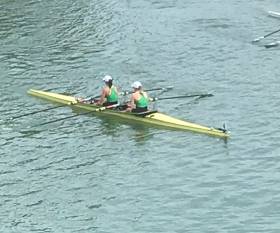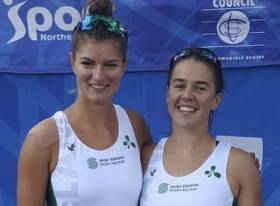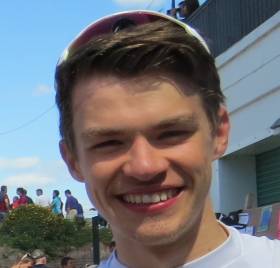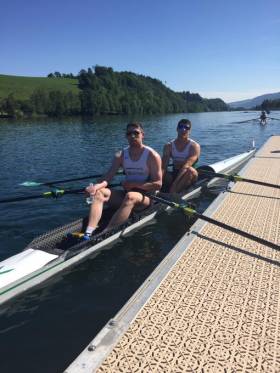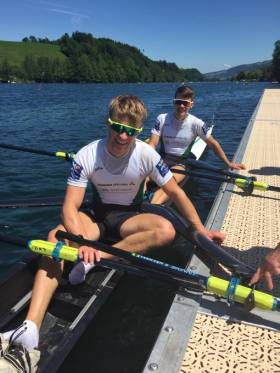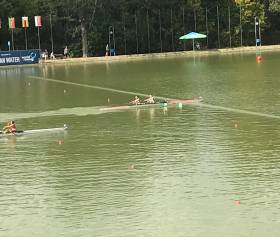Displaying items by tag: Denise Walsh
Fast Finish But Walsh and Casey Finish Fifth in C Final
#Rowing: Ireland's lightweight double of Aoife Casey and Denise Walsh took fifth in their C Final, 17th overall at the World Rowing Championships in Linz-Ottensheim this morning. China were strong winners. Ireland came from sixth to fifth in the second half of the race. They had the fastest final 500 metres but were held out of fourth by Germany - by .68 of a second.
World Rowing Championshiops, Linz-Ottensheim, Day Seven (Irish interest)
Women
Lightweight Double Sculls - C Final (Places 13 to 18) 1 China 7:00.82; 5 Ireland (A Casey, D Walsh) 7:10.52.
#Rowing: Aoife Casey and Denise Walsh finished third in their C/D Semi-Final at the World Championships and qualified for the C Final. China, Germany and Ireland held that order through the great bulk of the race, but Ireland closed hard on Germany coming to the line, missing out on catching them by just .18 of a second.
World Rowing Championships, Linz-Ottensheim, Austria - Day Five (Irish interest)
Men
Lightweight Double Sculls - A/B Semi-Final Two (First Three to A Final; rest to B Final): 1 Ireland (F McCarthy, P O'Donovan) 6:13.46, 2 Germany 6:13.59, 3 Norway 6:14.15.
Lightweight Single Sculls A/B Semi-Final One (First Three to A Final; rest to B Final): 6 Ireland (G O'Donovan) 7:34.01.
Women
Four A/B Semi-Final Two (First Three to A Final; rest to B Final): 1 Australia 6:25.34, 2 Denmark 6:28.58, 3 Romania 6:30.96; 4 Ireland (T Hanlon, E Lambe, A Keogh, E Hegarty) 6:32.37.
Pair - A/B Semi-Final One (First Three to A Final; rest to B Final): 1 New Zealand 6:57.92, 2 United States 7:01.78, 3 Italy 7:01.80; 4 Ireland (A Crowley, M Dukarska) 7:03.05.
Lightweight Double Sculls - C/D Semi-Final One (First Three to C Final; rest to D Final): 3 Ireland (A Casey, D Walsh) 7:01.68.
Lightweight Single Sculls A/B Semi-Final One (First Three to A Final; rest to B Final): 6 Ireland (L Heaphy) 7:42.23.
Casey and Walsh Take Their Place in Quarter-Finals in Linz
#Rowing: Aoife Casey and Denise Walsh finished fourth in their heat and qualified for the quarter-finals of the lightweight double sculls at the World Rowing Championships in Linz, Austria. The top three in the race will all have ambitions of taking a medal come next weekend: France won from South Africa and China. Walsh and Casey did enough to stay clear of Thailand and nab the final qualification spot.
World Rowing Championships, Linz, Austria, Day One (Irish interest)
Men
Pair – Heat One (First Four to Quarter-Finals; rest to Repechage): 6 Ireland (M O’Donovan, S O’Driscoll) 6:50.51.
Lightweight Double Sculls – Heat Three (First Three to Quarter-Finals; rest to Repechage): 1 Ireland (F McCarthy, P O’Donovan) 6:28.02
Women
Pair – Heat Four (First Four to Quarter-Finals; rest to Repechage): 2 Ireland (A Crowley, M Dukarska) 7:13.30
Lightweight Double Sculls – Heat Four (First Four to Quarter-Finals; rest to Repechage): 4 Ireland (A Casey, D Walsh) 7:25.62.
Ireland's Dukarska and Crowley Sixth at Rotterdam World Cup
#Rowing: Ireland's Aileen Crowley and Monika Dukarska took sixth in the A Final of the women's pairs at the World Cup Regatta in Rotterdam. Ireland featured well in the early stages, but Australia and New Zealand moved away. They would finish in that order after a good battle. Britain took the bronze. Ireland and Spain battled for fifth, with Spain taking it by 1.63 seconds.
Lydia Heaphy and Denise Walsh finished sixth in their B Final of the lightweight double sculls, to take 12th overall.
World Cup Regatta, Rotterdam, Day Three (Irish interest)
Women
Pair - A Final: 1 Australia 7:26.15, 2 New Zealand 7:27.57, 3 Britain 7:40.51; Ireland (A Crowley, M Dukarska) 7:50.08.
Lightweight Double Sculls - B Final (places 7 to 12): 6 Ireland (L Heaphy, D Walsh) 7:45.98.
#Rowing: Paul O'Donovan and Fintan McCarthy brought the tally of Ireland A Finalists at the World Cup Regatta in Rotterdam to four with a second-placed finish in their semi-final. Germany's Jason Osborne and Jonathan Rommelmann, racing in the favoured lane one were the dominant crew, but the new Ireland lightweight double finished fast, coming to just about a length on the line.
The Ireland women's lightweight double were out in lane six in the revised lane draw in their semi and finished sixth. Lydia Heaphy and Denise Walsh are set for a B Final.
World Cup Regatta, Rotterdam, Day Two (Irish interest; morning session)
Men
Double Sculls - Semi-Final Two (First Three to A Final; rest to B Final): 1 Ireland (P Doyle, R Byrne) 6:33.47, 2 Germany 6:36.17, 3 Australia One 6:38.62
Lightweight Double Sculls - Semi-Final Two (First Three to A Final; rest to B Final): 1 Germany One 6:42.04, 2 Ireland (F McCarthy, P O'Donovan) 6:43.70, 3 Australia 6:50.80.
Lightweight Single Sculls - Semi-Final Two (First Three to A Final; rest to B Final): 1 Slovenia 7:22.30, 2 3 Ireland One (G O'Donovan) 7:25.89, 3 Switzerland 7:27.70; 4 Ireland Two (J McCarthy) 7:34.79.
Women
Pair - Semi-Final One (First Three to A Final; rest to B Final): 1 Romania One 7:34.61, 2 Ireland (A Crowley, M Dukarska) 7:37.87, 3 Spain 7:39.49.
Lightweight Double Sculls - Semi-Final Two (First Three to A Final; rest to B Final): 6 Ireland (L Heaphy, D Walsh) 7:49.87.
Italy Catch Doyle and Byrne on Line at European Rowing
#Rowing: Ireland’s Philip Doyle and Ronan Byrne finished fourth in their B Final, tenth overall, at the European Rowing Championships in Lucerne this morning. In a good race with an exciting finish, Germany led off as if they intended to dominate. Ireland headed a pack of three who were closest to them. Lithuania were fastest through the last 700 metres and almost caught Germany on the line, while Ireland were pushed out of third by Italy by 17 hundredths of a second.
Lydia Heaphy and Denise Walsh took sixth in their B Final, 12th overall. The Netherlands were impressive winners.
European Championships, Lucerne, Day Three (Irish interest)
Men
Double Sculls – B Final (Places 7 to 12): 1 Germany 6:19.30, 2 Lithuania 6:19.44, 3 Italy 6:22.64, 4 Ireland (P Doyle, R Byrne) 6:22.81
Women
Lightweight Double Sculls – B Final (Places 7 to 12): 1 Netherlands 7:05.12; 6 Ireland (D Walsh, L Heaphy) 7:22.38.
#Rowing: The McCarthy twins, Jake and Fintan, took their place in the A Final of the lightweight double sculls at the European Rowing Championships in Lucerne today. They slotted into third place in their semi-final, almost level with Spain after both crews had chased the winners, Germany. The Czech Republic missed out in fourth.
The Ireland women’s lightweight double of Lydia Heaphy and Denise Walsh took sixth in their semi-final and go the the B Final.
European Championships, Lucerne, Day Two (Irish interest)
Men
Double Sculls – Semi-Final One (First Three to A Final; rest to B Final): 1 Netherlands 6:11.71, 2 Britain 6:12.61, 3 France 6:13.81; 4 Ireland (P Doyle, R Byrne) 6:14.37.
Lightweight Double Sculls - Semi-Final One (First Three to A Final; rest to B Final): 1 Germany 6:16.29, 2 Spain 6:17.83, 3 Ireland (F McCarthy, J McCarthy) 6:17.97; 4 Czech Republic 6:18.78.
Lightweight Single Sculls – C Final (Places 13 to 17): 1 Austria (R Kepplinger) 7:09.42; 4 Ireland (G O’Donovan) 7:18.11.
Women
Lightweight Double Sculls – Semi-Final Two (First Three to A Final; rest to B Final): 1 Switzerland 6:55.47, 2 Italy 6:55.92, 3 Romania 6:56.25; 6 Ireland (D Walsh, L Heaphy) 7:18.75.
McCarthys Shine at European Rowing
#Rowing: Jake and Fintan McCarthy produced a brilliant final sprint to take a place in the semi-finals of the lightweight double sculls at the European Rowing Championships in Lucerne today. Just two crews would go through, and Italy led the way. The world silver medallists stayed ahead of a tight pack of challengers, with Ukraine closest as they came to the line. But the McCarthy twins upped their rate and pushed Ukraine out of a qualifying spot by a quarter of a second.
Lydia Heaphy and Denise Walsh, a new crew, did very well to qualify directly for their semi-final. They took the third and final qualifying spot in their heat. Switzerland and Britain fought it out at the head of the field, with Ireland holding off Spain and Sweden.
European Championships, Lucerne, Day One (Irish interest)
Men
Double Sculls – Heat One (First Two to A/B Semi-Finals; rest to Repechages): 1 Ireland (P Doyle, R Byrne) 6:26.53, 2 Romania 6:29.62.
Lightweight Double Sculls – Heat Two (First Two to A/B Semi-Finals; rest to Repechages): 1 Italy (S Oppo, P Ruta) 6:14.73, 2 Ireland (J McCarthy, F McCarthy) 6:16.07; 3 Ukraine 6:16.32.
Lightweight Single Sculls – Heat One (First Two to A/B Semi-Finals; rest to Repechages): 1 Italy (M Goretti) 7:05.54, 2 Switzerland (J Schaeuble) 7:06.73; 6 Ireland (G O’Donovan) 7:34.73.
Women
Single Sculls – Heat Three (First Two to A/B Semi-Finals; rest to Repechages): 1 Ireland (S Puspure) 7:30.65, Britain (V Thornley) 7:35.35
Lightweight Double Sculls – Heat Three (First Three to A/B Semi-Finals; rest to Repechages): 1 Switzerland 6:57.58, 2 Britain 6:58.61, Ireland (D Walsh, L Heaphy) 7:14.55.
Casey and Walsh Finish World Championships With C Final Win
#Rowing: Ireland’s Aoife Casey and Denise Walsh showed the Skibbereen skill for sprinting to good effect as they worn their C Final of the women’s lightweight double sculls at the World Championships in Plovdiv. They were fourth at 500 metres, but they sped up the rankings through the middle 1,000 and led with 500 metres to go. They took it home from there, with Austria second and Germany third. Ireland placed 13th in the World because of this result.
Shane O’Driscoll and Mark O’Donovan took fourth in their C Final, 16th overall, in the men’s pair. The race was won by Australia’s Andrew Judge and Joseph O’Brien, while O’Donovan and O’Driscoll produced a remarkable change of pace to challenge the leaders, but Poland and the United States had pushed in between them and the leaders on the line.
World Rowing Championships, Plovdiv, Bulgaria, Day Seven (Irish interest):
Men
Pair – C Final (places 13 to 18): 1 Australia 6:23.81; 4 Ireland (M O’Donovan, S O’Driscoll) 6:29.19.
Lightweight Double Sculls – A Final: 1 Ireland (G O’Donovan, P O’Donovan) 6:06.81, 2 Italy 6:08.31, 3 Belgium 6:11.25.
Women
Pair – A Final: 1 Canada 6:50.67, 2 New Zealand 6:52.96, 3 Spain 7:04.60; 6 Ireland (A Keogh, E Hegarty) 7:15.70.
Lightweight Double Sculls – C Final (places 13 to 18): 1 Ireland (A Casey, D Walsh) 7:05.77, 2 Austria 7:08.29, 3 Germany 7:09.12.
Casey and Walsh Win C/D Semi-Final at World Rowing
#Rowing: Aoife Casey and Denise Walsh won their C/D Semi-Final and qualfied for the C Final at the World Rowing Championships in Plovdiv today. The first two would go to the C Final, and it was clear early in the race that these would be Spain and Ireland. Thailand trailed this two. Spain led and looked set to win – but Casey and Walsh won the battle at the head of the field with Spain.
World Rowing Championships, Plovdiv, Bulgaria, Day Five (Irish interest)
Men
Pair – Quarter-Final Four (Three to A/B Semi-Finals; rest to C/D Semi-Finals): 1 Canada 6:26.04, 2 New Zealand 6:30.36, 3 Czech Republic 6:35.01; 5 Ireland (M O’Donovan, S O’Driscoll) 6:44.28.
Double Sculls – Repechage Four (First Two to A/B Semi-Final):
Ireland (P Doyle, R Byrne) 6:16.96, 2 Bulgaria 6:20.15.
Lightweight Double – Semi-Final Two (Three to A Final; rest to B Final): 1 Italy 6:21.94, 2 Belgium 6:22.83, 3 Ireland (G O’Donovan, P O’Donovan) 6:23.78.
Women
Pair – Semi-Final (Three to A Final; rest to B Final): 1 Ireland (A Keogh, E Hegarty) 7:14.67, 2 Italy 7:14.99, 3 Spain 7:15.30.
Lightweight Double Sculls – C/D Semi-Final (First Two to C Final; rest to D Final): 1 Ireland (A Casey, D Walsh) 7:20.51, 2 Spain 7:24.08.


























